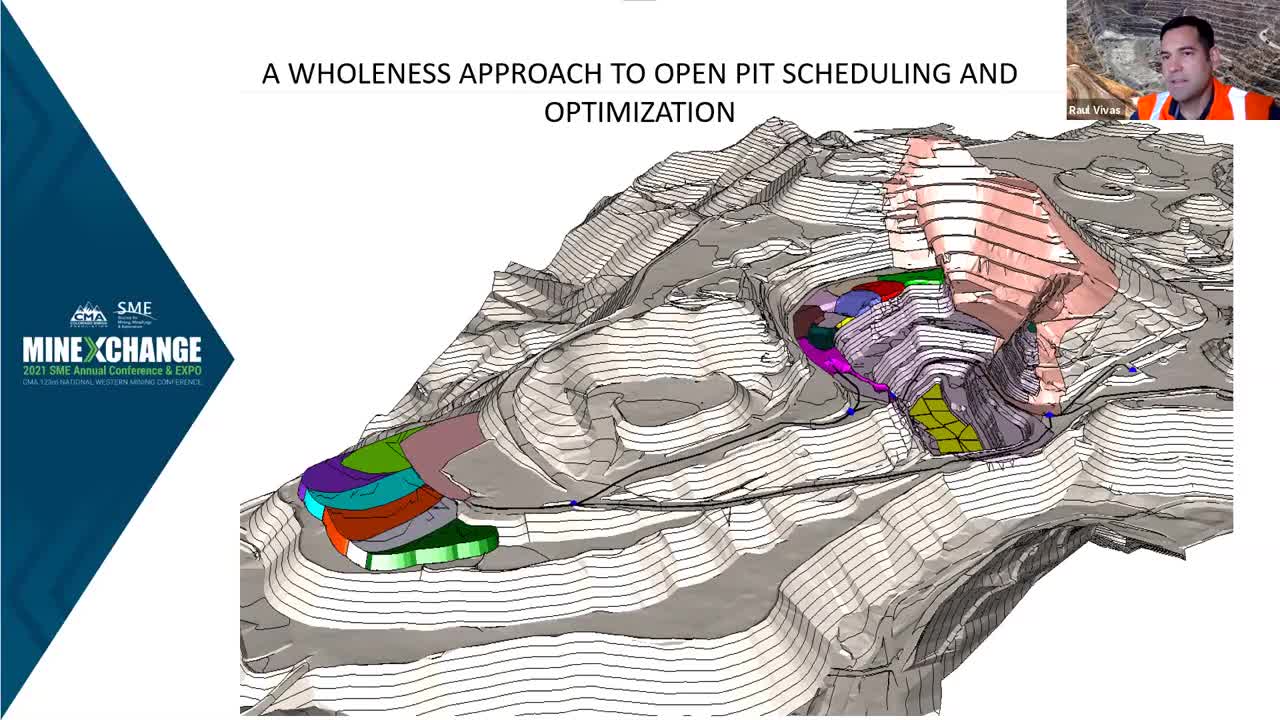The mining industry reports hundreds of billions of dollars in revenue every year. Most of this value is forecasted ahead of time and reported in the life-of-mine and budget plans.
Mine planners evaluate and update several mine plans on a regular basis. Traditionally, long, medium and short-range plans have been prepared in bits and pieces by multiple departments, teams and software.
A wholeness approach requires the integration of mine plans across multiple planning horizons as shown in the image below:
Similarly, the approach requires integration of the extraction plan, the haul plan and the dump plan all formulated and solved as one problem. Ultimately, mine plans must be reconciled against mine operations with the aim to reduce the variance between planning and execution and thus achieve important project milestones.
For every cut that is mined, hauled and dumped, there is an associated cost, revenue and a direct impact on project value. There are some questions that must be examined like what is the value of the plan? Is it the best plan? Where are we excavating? Is the shovel in the right location? Where are we dumping in each period and how does that impact truck requirements over time? How is the material routed from the excavation source to the dumping destination? What are the haulage costs and distances associated with the material movement?
Answers to these questions may help us understand the mine plan and its value. Every time a mine planner creates a new iteration of the mine plan, additional information and details are included.
Some mines can move more than one million tons of material per day. Assuming an average mining cost of one dollar per ton, the value of just moving material can be worth more than one million dollars per day for large operations. So, if the value of a mine plan can be worth hundreds of millions of dollars, in some cases billions of dollars, it’s easy to argue that mine planners increase fortunes every time the mine plan is improved. It should be noted that the improvement can be measured and compared against alternative plans for trade-off analysis and to help with the decision-making process.
As previously mentioned, every time a mine plan is updated there is an opportunity to improve it. Here is an example, the image above shows a comparison between some haulage aspects of the LOM from 2012 and 2016 for a mining project. The 2016 LOM shows an optimized discharge plan for the waste dumps which results in lower capital and operating costs for trucks and shovels. This optimization was not the result of trial and error in which the shovel, haul, and dump plans are solved separately and manually through endless iterations. Instead, this is the result of an optimization where all parameters are integrated and solved together as one optimization problem.
There are several implications downstream as the results of mine planning studies are used in support of public company filings related to the disclosure of resources, reserves, and financial data with organizations such as the Securities and Exchange Commission. Similarly, mine planning studies support the investment of hundreds of millions of dollars in assets such as trucks, shovels and drills. Thus, it would be logical to assume that optimizing the haulage aspect of the schedule has a significant impact on project value. Extending and maximizing the life and use of the mine assets can be done with the assistance and implementation of mining software for both planning and operations.
Similarly, mine planning studies support and guide important capital investment projects such as mill expansions, as shown in the images below:
Over the past decades, we have become accustomed to the term “mine to mill”. It is a simple term to describe a complex multi-layered process in the mining cycle. For example, what happens when you have multiple mills, each one with a different throughput? This presents a challenge for both mine planners and operators. Let’s suppose that a project has two different-sized mills, each with different throughputs. In addition to that, ore materials have a variable tonne per hour milling rate for each mill, which depends on several factors such as the mineral type, rock type, rock hardness and fragmentation. So, the mill hours associated with processing ore blocks at the big mill and the small mill are set up as variables in the orebody model, as shown below:
Mill throughput depends, among other things, on rock fragmentation. This slide shows how image recognition analysis from Hexagon allows us to monitor and measure the rock fragmentation from post blast product, to belt conveyors all the way to the mill feed. A network of cameras and intelligent image recognition software is used to monitor crushing, conveying and grinding circuits. Oversized rock can be quickly screened out to prevent disruptions in production. Drill and blast patterns and designs can be adjusted to improve fragmentation, reduce mill energy consumption, and increase plant throughput, all of which have a direct impact on revenue.
In addition to monitoring fragmentation there are many other aspects of the mine that must be supervised. Control rooms allow the mines to oversee the operation and keep track of production KPIs in real time. Fleet management systems are used to monitor the operation, operators and plan compliance.
The implementation of mine planning software and mine monitoring systems have resulted in significant increases in production and revenue while realizing lower operational and capital costs.
Generating the best possible mine plan requires a wholeness approach and monitoring its execution is key to make sure the operation stays on track and that business objectives are achieved.
Aligning mine planning with mine operations is critical to realize maximum project value. At hundreds of mines throughout the world, both planning and operation solutions from Hexagon are used to this end.
To read the complete paper, A Wholeness Approach to Open Pit Scheduling and Optimization, click here.




















